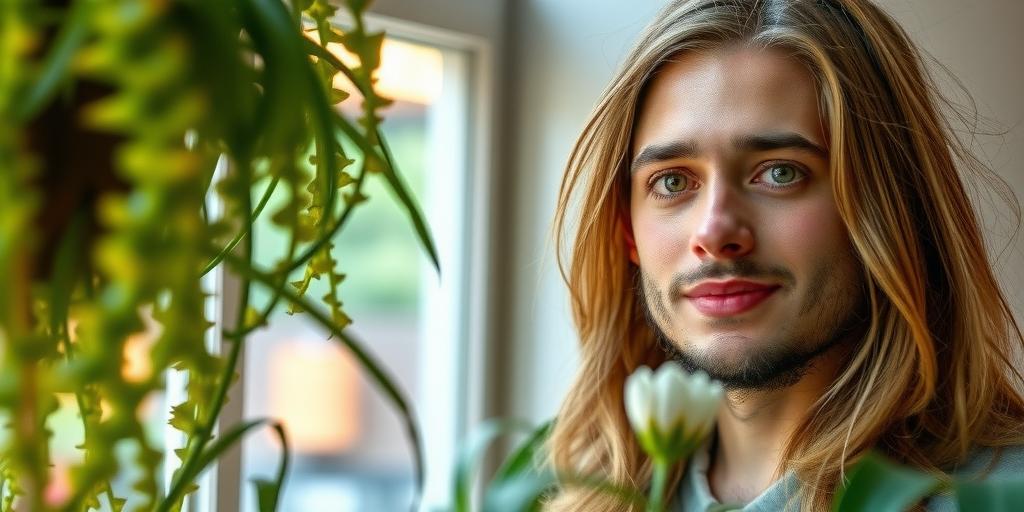
The Ultimate Guide to Nearly Indestructible, Low-Light Hanging Plants for 2025
Discover the best low-light hanging plants that are tough to kill! This guide reveals resilient, shade-tolerant varieties and expert care tips to effortlessly greenify your space. Perfect for busy plant parents!
Introduction
Does that dark corner of your room feel a little… empty? You want the lush, vibrant energy that plants bring, but your space lacks bright, direct sun. And if you’re anything like me, your track record with keeping greenery alive might be a bit checkered. Well, I have great news! Forget everything you think you know about finicky flora. Some of the most beautiful hanging plants aren’t just tolerant of low light—they’re practically indestructible. I’ve killed my fair share of plants, but the varieties we’re talking about today? They’ve survived my neglect and thrived. Get ready to transform your home into a thriving urban jungle, no sunny window required!
Why Choose Resilient Low-Light Hanging Plants?
If you’ve ever walked into a room and felt like something was missing, chances are it was a touch of greenery. But what if your space doesn’t get much natural light? That’s where resilient low-light hanging plants come in. These aren’t just any plants—they’re specially adapted to thrive in less-than-ideal lighting conditions, making them perfect for apartments with small windows, offices under fluorescent lights, or even that awkward corner in your hallway that never sees the sun.
One of the biggest perks of these plants is how beginner-friendly they are. If you’re just starting your plant parent journey, or if your schedule is so packed that remembering to water feels like a chore, low-light hanging plants are your new best friends. They’re forgiving, slow to show distress, and many can go longer between waterings than their sun-loving counterparts. Plus, if you travel frequently, these plants won’t hold a grudge while you’re away.
But it’s not just about convenience—these plants are also hard at work improving your indoor air quality. Many low-light varieties, like spider plants and pothos, are known for their air-purifying abilities. They absorb common toxins such as formaldehyde and benzene, helping to create a cleaner, healthier atmosphere in your home or workspace. It’s like having a silent, leafy roommate who’s always on detox duty.
And let’s not forget the visual impact. There’s something magical about how a trailing plant can soften a room’s edges, add depth to high shelves, and bring life to those dark, forgotten corners. Whether you prefer the lush, cascading vines of a heartleaf philodendron or the architectural interest of a ZZ plant, these green companions provide an instant aesthetic upgrade with minimal effort.
Top 7 Nearly Indestructible Low-Light Hanging Plants
When it comes to choosing the right plant for your space, it helps to have a shortlist of proven performers. Here are seven nearly indestructible options that thrive in low light and look stunning when hung.
Heartleaf Philodendron
This plant is a true classic—and for good reason. With its heart-shaped leaves and vigorous vining habit, the heartleaf philodendron adapts to almost any condition. It grows quickly, trails beautifully, and can handle occasional neglect like a champ. It’s the kind of plant that makes you look like you have a green thumb, even if you’re just starting out.
Pothos (Devil's Ivy)
If there were a crown for the most forgiving houseplant, pothos would wear it. Often called Devil’s Ivy because it’s almost impossible to kill, this plant thrives on neglect. Forget to water it? No problem. Low light? It won’t complain. With varieties like golden pothos, marble queen, and neon, there’s a color and pattern to suit every taste.
Spider Plant
A favorite for households with pets or small children, spider plants are non-toxic and incredibly easy to care for. They produce plenty of “pups”—baby spider plants that dangle from the mother plant like little green fireworks. These can be propagated easily, so one spider plant can soon turn into many. They tolerate low light well and help purify the air, making them both practical and pretty.
ZZ Plant (Zamioculcas zamiifolia)
If you’re looking for a plant that’s virtually indestructible, meet the ZZ plant. Its glossy, waxy leaves not only look great but also store water in underground rhizomes, allowing it to survive long periods without watering. It thrives in low light and is highly resistant to pests. This is the plant you want if your track record with houseplants is… well, let’s just say checkered.
Parlor Palm
For a touch of elegance, the parlor palm is an excellent choice. Its feathery, arching fronds bring a classic, sophisticated look to any room. It doesn’t demand much light and grows slowly, so it won’t outgrow its space too quickly. It’s perfect for adding a soft, tropical vibe without the high maintenance.
Peperomia (e.g., Obtusifolia)
Peperomias are compact, charming plants with thick, water-retaining leaves that make them very drought-tolerant. The obtusifolia variety, with its spoon-shaped leaves, is particularly suited to low light. It stays relatively small, making it ideal for smaller hanging pots or mixed planters. Plus, its cute appearance adds a playful touch to your indoor jungle.
String of Hearts
This trailing succulent is as beautiful as it is resilient. With its delicate, heart-shaped leaves and long tendrils, it’s perfect for hanging baskets where it can cascade freely. While most succulents prefer bright light, string of hearts is more forgiving in lower light conditions than its cousin, string of pearls. It’s a gorgeous way to add romance and texture to your space.
Essential Care Tips for Thriving Low-Light Plants
Even the hardiest plants need a little TLC to look their best. Here’s how to keep your low-light hanging plants healthy and happy.
Master the "Soak and Dry" Watering Method
Overwatering is the number one killer of houseplants, especially those in low light. Since these plants use water more slowly, it’s crucial to let the soil dry out between waterings. The “soak and dry” method involves thoroughly watering the plant until water runs out of the drainage holes, then waiting until the top inch or two of soil is dry before watering again. This prevents root rot and keeps your plant’s roots healthy.
Less Light Means Less Water and Fertilizer
It’s a simple equation: less light equals slower growth, which means your plant needs less water and fewer nutrients. During the darker months, you might only need to water every few weeks. Similarly, fertilize sparingly—once every couple of months during the growing season (spring and summer) is usually sufficient. Over-fertilizing can lead to salt buildup and leaf burn.
Choose the Right Potting Mix and Container
Well-draining soil is non-negotiable. Look for a potting mix designed for indoor plants, and consider adding perlite or orchid bark to improve drainage. The container matters too—make sure it has drainage holes to allow excess water to escape. Hanging pots can dry out faster than those on surfaces, so keep an eye on moisture levels.
Identify and Correct Signs of Distress
Even low-maintenance plants can have off days. Yellowing leaves often indicate overwatering, while brown, crispy tips might mean the air is too dry. Leggy growth—where the plant stretches toward the light—suggests it needs a slightly brighter spot. Most issues are easy to fix once you identify them: adjust watering, move the plant, or trim away unhealthy growth.
Dust the Leaves Occasionally
In low light, every bit of photosynthesis counts. Dust can block light absorption, so gently wipe the leaves with a damp cloth every few weeks. This not only helps the plant breathe but also keeps it looking shiny and vibrant.
Styling Ideas for Your Hanging Indoor Jungle
Once you’ve chosen your plants and learned how to care for them, it’s time to have fun with styling. Hanging plants offer unique opportunities to elevate your interior design.
Mix and Match Leaf Shapes and Textures
Create visual interest by combining plants with different foliage. Pair the large, glossy leaves of a heartleaf philodendron with the fine, feathery fronds of a parlor palm, or let the succulent trails of a string of hearts contrast with the variegated patterns of a pothos. Variety is key to a dynamic, lush look.
Use Macramé Hangers, Ceiling Hooks, and Shelves
Don’t limit yourself to standard plant hangers. Macramé hangers add a boho-chic vibe, while ceiling hooks can help you create layers of greenery at different heights. Wall-mounted shelves are perfect for displaying a collection of smaller hanging plants, turning a blank wall into a living art installation.
Group Plants to Boost Humidity
Plants release moisture through transpiration, so grouping them together can create a mini-microclimate with slightly higher humidity. This is especially beneficial for tropical plants like philodendrons and pothos. Cluster a few hanging plants near each other, and they’ll help each other thrive.
Frame Windows, Bookshelves, or Archways
Use trailing plants to draw the eye and define spaces. Hang a spider plant or string of hearts near a window to frame the view, or let a pothos cascade from a high bookshelf to soften the edges. In archways or between rooms, hanging plants can act as natural, graceful dividers that add depth and drama to your home.
Conclusion
See? Creating a lush, green sanctuary in your home doesn’t require a green thumb or a sun-drenched conservatory. With these resilient low-light hanging plants, you’re equipped to bring life into any space. From the steadfast Pothos to the architectural ZZ plant, there’s a nearly indestructible option ready to thrive under your care. So, what are you waiting for? Pick your favorite from this list, grab a beautiful pot, and start your low-maintenance plant journey today. Your new leafy friends are ready to forgive the occasional missed watering and reward you with years of growth. Share your plant success stories with us in the comments below!
